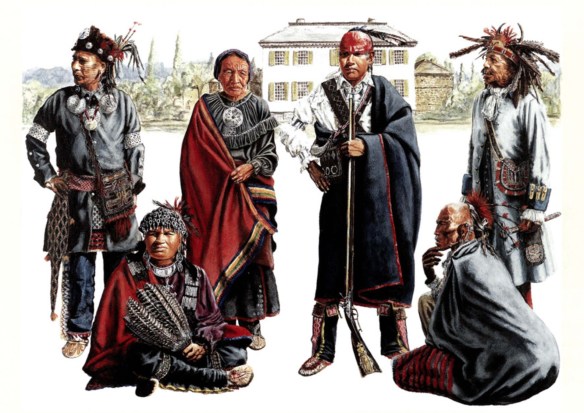The commercial trade between the Ohio American Indians and French or British agents and traders during the 18th century was of a different nature to previous trading. It degenerated into competition for Indian alliances by means of gifts. War gifts of cutlasses, scalping knives, hatchets, guns, powder, and bullet molds were added to vermilion paint, flints, cottons, blankets, scissors, needles, thread, cloth, watchcoats, and stockings. Once the Indians had become accustomed to the white man’s goods, they could not live without them. Unscrupulous traders plied Indians with rum, which often resulted in intoxication, brawls, and death. The French gradually regained the upper hand in the Indian trade during the first half of the 18th century, and they were in control of the Ohio area in 1754.
The eastern Woodland Indians, especially the Canadian Iroquois and Abenakis, were among the most steadfast allies of the French in Canada. Their villages were often close to the French settlements and they served with the Canadian militia. Most of the western Woodland tribes – Ottawa, Ojibwa, Potawatomi, and Shawnee – were also allies of the French. The Hurons who had finally settled in the Ohio Valley following the dispersal of their confederacy by the Iroquois in the mid-17th century were known as the Wyandot. Allied with the Ottawa, they were the “eldest children” of Onontio, the governor-general of New France, and the cornerstone of the French alliance with the Great Lakes Algonkians. Although their relations with the French were tempestuous for many years, when war broke out in the Ohio Valley, the Wyandot sided with the French, and with the other French allies went east to fight in the French campaigns in northern New York.
The Iroquois for the most part fought on the side of the English, in part due to the influence of the British Superintendent of Indian Affairs, Sir William Johnson. The Irish trader George Croghan, in the British service of Sir William Johnson, won over the friendship of the western Indians at a great council in Pittsburgh in 1758.
Following the battle of Lake George, Sir William exerted himself to keep the Iroquois friendly to Britain’s cause, or at least neutral, despite a series of disheartening military failures. The Iroquois fulfilled a campaign of diplomatic pressure by bringing the Delawares and Shawnees to heel at the treaty of Easton in October 1758, and they played a major part in the final British victory. However, following the end of the war, the actions of Amherst destroyed the relations with the western nations and led to Pontiac’s War.
William Johnson and the Mohawks
William Johnson, a young Anglo-Irishman, came to the Mohawk Valley in 1738. He built a huge commercial empire from the fur trade and land deals. Within three years he had built a fortress-like home, Mount Johnson, and had begun a long association with the Mohawks. His second wife, Caroline, was the niece of old “King Hendrick.” After her death he married as his third wife Molly Brant whose younger brother, Joseph Brant, was destined to become a captain in the British Army during the American Revolution. In 1745 Johnson was appointed British Commissioner of Indian Affairs, and in 1755, Superintendent of Indian Affairs. His victory at Lake George, supported by hundreds of Mohawks and Oneidas, was heartening to the British colonists, although King Hendrick was one of those killed in the fighting. Through this victory Johnson united the Iroquois behind him, and was rewarded by the Crown with a baronetcy and cash grant. Johnson spent the rest of the war trying to keep the Iroquois friendly to Britain’s cause. He took Fort 62 Niagara in 1759 with a force augmented by over 900 Iroquois warriors. Johnson’s home was palisaded in 1755 and became known as Fort Johnson, but with the return of peace he built a stately home called Johnson Hall at Johnstown, NY, where he sheltered Indians and entertained other distinguished guests. This illustration shows various distinguished Indian visitors to Johnson Hall, from left, an Ottawa chief a Wyandot chief a clan matron, Joseph Brant, a Fox chief and a Huron chief. As many as 60 to 80 Indians often camped in the grounds. His actions helped to bring about the end of Pontiac’s War in 1766, and in 1768 he made a formal treaty with all the Indians which set out the boundaries between the American colonies and Indian country. Johnson was adopted as a war chief of the Canajoharie Mohawks; his nickname was Orihwane, “Big Business.” He had a unique influence with the Mohawks, and through his many children he has descendants among them today. Jonathan Smith
